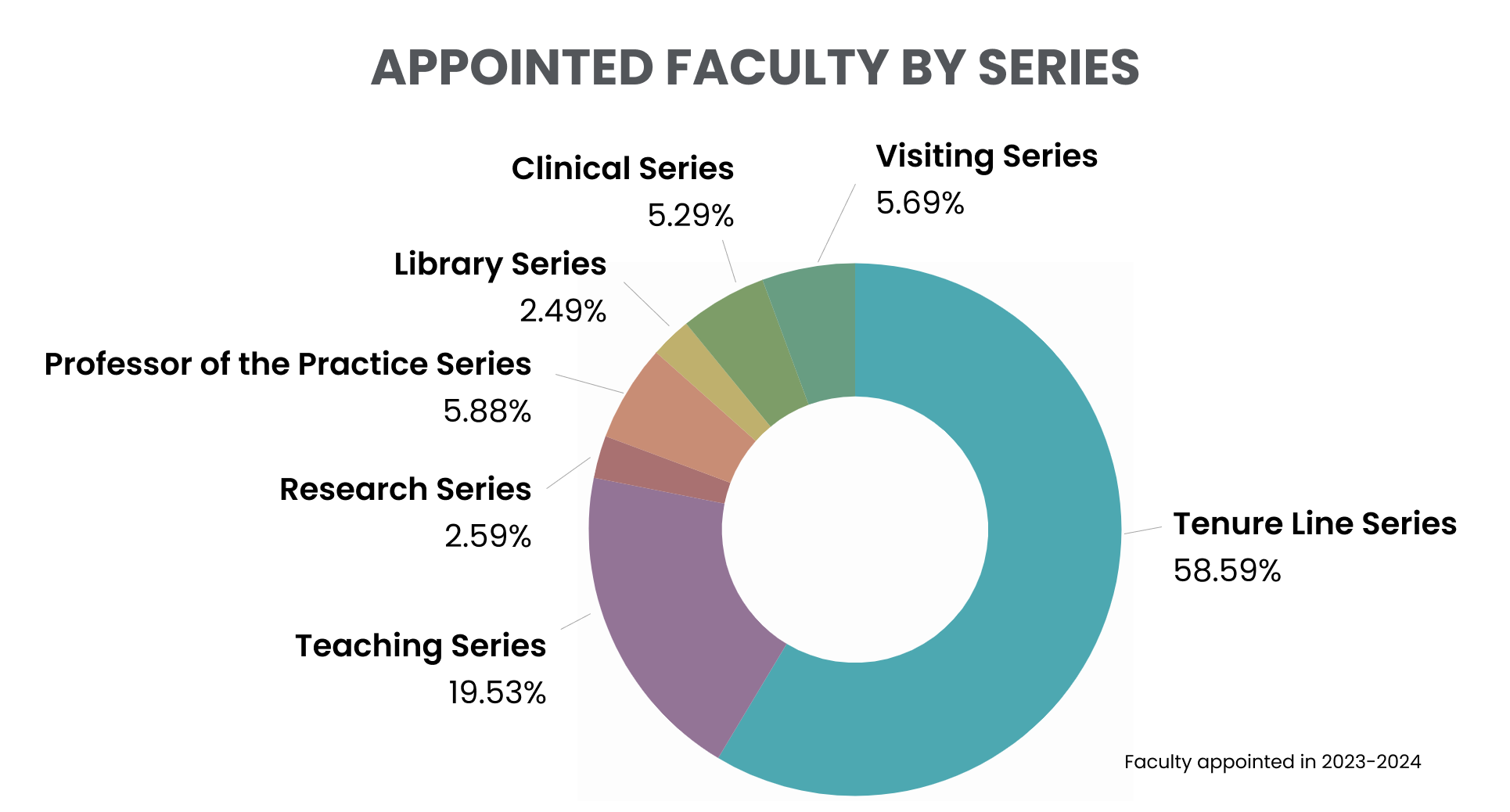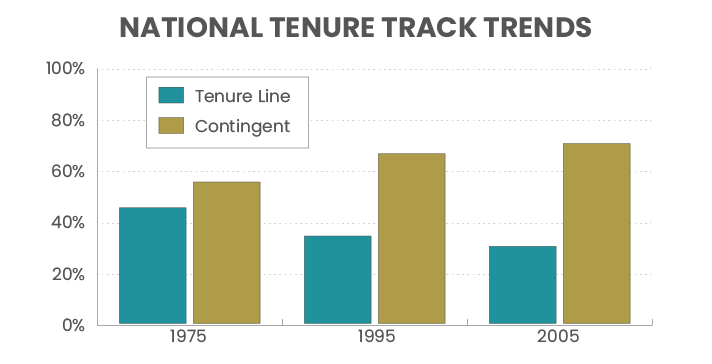Non-tenure track faculty are a growing population of faculty in higher education. Here at DU, We’ve created and professionalized our faculty off the tenure track by creating a series of Teaching and Professional Faculty.
DU BACKGROUND
In 2015, the University of Denver joined a growing cadre of higher education institutions that are changing policies and procedures to honor the contributions of full-time faculty off of the tenure track (Pullias Center, n.d.). These changes and best practices include full time employment, longer term contracts, opportunities for advancement and promotion, and participation in shared governance. DU has taken steps to create a more collegial work environment for all faculty, with attention to the Teaching and Professional Faculty, through the Office of the Vice Provost for Faculty Affairs.

National Background
Approximately 70% of faculty in the United States are off the tenure track (AAUP , 2018) – a statistic that is widely cited to highlight the changing role of the faculty in U.S. higher education. This number takes into account all non-tenure track faculty – those in full time, part time, adjunct instructor, lecturer, or research roles. Increasingly literature and research are parsing these groups to better understand the differences among faculty roles and experiences and some institutions are working to ameliorate these disparities.

Definitions of Faculty Series
The following definitions are provided from the University of Denver’s Policies and Procedures Relating to Faculty Appointment, Promotion, & Tenure.
“Faculty appointments fall into the following series: Tenure-Line Professorial Series, Professorial Series in University Libraries, Teaching Professorial Series, Clinical Professorial Series, Professor of the Practice Series, Research Professorial Series, Adjunct Professorial Series, Visiting Professorial Series, In-Residence Series, and the Emeritus Professorial Series. These categories of faculty appointments and their associated titles are described below. Appointments that use categories other than those specified herein are not to be considered “faculty” appointments” (p. 9).
Tenure Line Professorial Series
The tenure track is a professor’s pathway to promotion, academic job security, and academic freedom through tenure. A professor who is on the tenure track is expected to go up for a tenure review 6 years after starting the position. The tenure review evaluates a professor’s contributions in three areas: research, teaching, and service to the university. Ranks include assistant (untenured); associate and full professor.
Professorial Series in University Libraries
The University library faculty are faculty whose primary responsibility are to serve and work in the University Library. Ranks include instructor, assistant, associate and full professor.
Teaching Professorial Series
The Teaching Professorial Series is appropriate for appointments where special factors, such as experience or stature, may qualify the appointee as an excellent teacher in a particular field. At least 90% of the position is dedicated to teaching, participation in shared governance, and service to the University, profession, and public, and between 0% and 10% shall be devoted to scholarship and creative activity. Ranks include Teaching Professor, Teaching Associate Professor, Teaching Assistant Professor, and Teaching Instructor.
Clinical Professorial Series
The Clinical Professorial Series is appropriate where appointments involve primary responsibilities in specialized professional practice including teaching, supervising student internships, training, and participating in other practice components of degree programs. Responsibilities of clinical faculty members may encompass any area of professional practice and/or technical expertise and may include professional development. Ranks include Clinical Professor, Clinical Associate Professor, Clinical Assistant Professor, and Clinical Instructor.
Professor of the Practice Series
Faculty members in the Professor of the Practice Series have expertise, achievements, and reputations developed over a sustained period of time that qualify them to be distinguished professionals in an area of practice, although they might not have academic credentials or experience. A primary function of faculty members in the Professors of the Practice Series is to provide students with connections to the professional fields the students will be entering. This series includes the ranks of Professor of the Practice, Associate Professor of the Practice, and Assistant Professor of the Practice.
Research Professorial Series
The Research Professorial Series is appropriate for research positions in an academic unit. This series includes the ranks of Research Professor, Research Associate Professor, and Research Assistant Professor.
Adjunct Professorial Series
Adjunct faculty members fall into two categories. The first category consists of faculty members whose major assignment is in another academic unit of the University or outside the University. These faculty appointments are renewable and do not necessarily imply a remunerative relationship with the University. The second category is comprised of term-limited faculty members who are hired and paid in a non-benefitted capacity to teach on a per course basis. This series includes the ranks of Adjunct Professor, Adjunct Associate Professor, and Adjunct Assistant Professor.
Visiting Professorial Series
Appointments in the Visiting Professorial Series are term-limited appointments. The Visiting Professorial Series includes the ranks of Visiting Professor, Visiting Associate Professor, and Visiting Assistant Professor. In addition, “Visiting” may be added to the title of faculty members in other Faculty Series where appropriate. For example, faculty members may have the title of Visiting Research Professor, Visiting Teaching Professor, Visiting Clinical Professor, Visiting Professor of the Practice, and so on. However, the designation “Visiting” is not used as a designation for an adjunct appointment.
In-Residence Series
Appointments in the In-Residence Series are term-limited appointments. The In-Residence Series is appropriate to designate special contractual arrangements such as Poet-in-Residence, Artist-in-Residence, Scholar-in-Residence, or Executive-In-Residence. The length of appointment for faculty members in the In-Residence Series is usually less than two years.
Emeritus Professorial Series
The Emeritus Professorial Series includes the ranks of Emeritus Professor, Emeritus Associate Professor, Emeritus Teaching Professor, Emeritus Teaching Associate Professor, Emeritus Clinical Professor, Emeritus Clinical Associate Professor, Emeritus Professor of the Practice, Emeritus Associate Professor of the Practice, Emeritus Research Professor, and Emeritus Research Associate Professor, and is used to designate distinguished faculty members in retirement.
Creating Respectful, Inclusive and Collegial Culture for Teaching and Professional Faculty: A Scorecard
At DU, the office of the Vice President for Faculty Affairs has adopted a framework to analyze our policies and practices to create a respectful culture for all faculty. The framework looks at employment equity, academic freedom and autonomy, flexibility, professional growth, collegiality and respect. Institutions that attend to these areas have positive working environments, increased faculty satisfaction, increased commitment to the organization, and a more diverse faculty.
The following chart acts as a “scorecard” to help understand DU’s strengths and areas for growth in supporting Teaching and Professional Faculty.
The framework comes from The White Paper on Teaching and Professional Faculty – Institutionalizing a Culture of Respect for Teaching and Professional Faculty authored by Dr. Laura E. Sponsler, Clinical Assistant Professor, Higher Education. The White Paper reviewed literature about full-time non-tenure track faculty and faculty work, shared information about the different faculty lines at DU, and analyzed extant data to examine understand how well DU has institutionalized policies and practices to support TPF.
The findings are organized in the following chart that acts as a “scorecard” to help understand DU’s strengths and areas for growth in supporting Teaching and Professional Faculty.
Framework for Rethinking Faculty Work and WorkplacesConsistent Institutionalization |
||
| Employment Equity | Regularize hiring | |
| Clear role definitions | ||
| Clear contracts | ||
| Compensation and benefits | ||
| Appropriate office space; clerical support and equipment | ||
| Academic Freedom and Autonomy | Protection and Academic Freedom | |
| Involvement in Governance University Level | ||
| Flexibility | Involvement in Governance (Ability to participate in campus life) | |
| Professional Growth | Promotion and evaluation | |
| Professional Development and Mentoring | ||
| Collegiality | Systematic socialization | |
| Involvement in governance (attending meetings and participating on committees) | ||
| Respect | all policy recommendations relate to this area | |
For further background information about full-time non-tenure track faculty, please see this Literature Review. Additional information about faculty mentoring can be found on the Teaching and Professional Faculty Lifecycle: An Aspirational Model for the Onboarding and Mentoring of Teaching and Professional Faculty page.
References
American Association of University Professors. (2010 and 2018). Policies and reports. https://www.aaup.org/reports-publications/aaup-policies-reports
Gappa, J. M., Austin, A. E., & Trice, A. G. (2007). Rethinking faculty work: Higher education’s strategic imperative. Jossey-Bass.
Kezar, A. (2012). Embracing non-tenure track faculty: Changing campuses for the new faculty majority. Routledge
Pullias Center for Higher Education (n.d). https://pullias.usc.edu/
History of Support for Teaching and Professional Faculty
